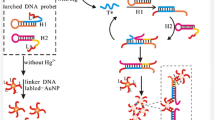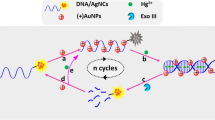Abstract
An optical method for determination of Hg(II) is described that exploits the aggregation of gold nanoparticles (AuNPs) under dark-field microscope (DFM) observation. This assay is based on the use of a Hg(II)-specific aptamer, AuNPs modified with complementary DNA strands, and exonuclease I (Exo I). In the absence of Hg(II), the added dsDNA prevents salt-induced aggregation of the green-colored AuNPs. If Hg(II) is added, the aptamer will capture it to form T-Hg(II)-T pairs, and the complementary strand is digested by Exo I. On addition of a solution of NaCl, the AuNPs will aggregate. This is accompanied by a color change from green to orange/red) in the dark-field image. By calculating the intensity of the orange/red dots in the dark-field image, concentration of Hg(II) can be accurately determined. The limit of detection is as low as 36 fM, and response is a linear in the 83 fM to 8.3 μM Hg(II) concentration range.

Schematic representation of a colorimetric assay for Hg(II) based on the use of a mercury(II)-specific aptamer, gold nanoparticles modified with complementary DNA strands, and exonuclease I.







Similar content being viewed by others
References
Das R, Giri S, Muliwa AM, Maity A (2017) High-performance hg(II) removal using thiol-functionalized polypyrrole (PPy/MAA) composite and effective catalytic activity of hg(II)-adsorbed waste material. ACS Sustain Chem Eng 5:7524–7536
Li WC, Tse HF (2015) Health risk and significance of mercury in the environment. Environ Sci Pollut Res 22:192–201
Chandra V, Kim KS (2011) Highly selective adsorption of Hg2+ by a polypyrrole-reduced graphene oxide composite. Chem Commun 47:3942–3944
Zhu ZL, Chan GCY, Ray SJ, Zhang XR, Hieftje GM (2008) Use of a solution cathode glow discharge for cold vapor generation of mercury with determination by ICP-atomic emission spectrometry. Anal Chem 80:7043–7050
Erxleben H, Ruzicka J (2005) Atomic absorption spectroscopy for mercury, automated by sequential injection and miniaturized in lab-on-valve system. Anal Chem 77:5124–5128
Yan WJ, Wang YJ, Zhuang H, Zhang JH (2015) DNA-engineered chiroplasmonic heteropyramids for ultrasensitive detection of mercury ion. Biosens Bioelectron 68:516–520
Rodrigues JL, Torres DP, Souza VCD, Batista BL, de Souza SS, Curtius AJ, Barbosa F (2009) Determination of total and inorganic mercury in whole blood by cold vapor inductively coupled plasma mass spectrometry (CV ICP-MS) with alkaline sample preparation. J Anal At Spectrom 24:1414–1420
Lin ZZ, Li XH, Kraatz HB (2011) Impedimetric immobilized DNA-based sensor for simultaneous detection of Pb2+, Ag+, and Hg2+. Anal Chem 83:6896–6901
Du YX, Liu RY, Liu BH, Wang SH, Han MY, Zhang ZP (2013) Surface-enhanced raman scattering chip for femtomolar detection of mercuric ion (II) by ligand exchange. Anal Chem 85:3160–3165
Jing C, Gu Z, Ying YL, Li DW, Zhang L, Long YT (2012) Chrominance to dimension: a real-time method for measuring the size of single gold nanoparticles. Anal Chem 84:4284–4291
Xu X, Li T, Xu Z, Wei H, Lin R, Xia B, Liu F, Li N (2015) Automatic enumeration of gold nanomaterials at the single-particle level. Anal Chem 87:2576–2581
Shi L, Jing C, Ma W, Li DW, Halls JE, Marken F, Long YT (2013) Plasmon resonance scattering spectroscopy at the single-nanoparticle level: real-time monitoring of a click reaction. Angew. Chem. Int Ed 52:6011–6014
Jing C, Gu Z, Xie T, Long YT (2016) Color-coded imaging of electrochromic process at single nanoparticle level. Chem Sci 7:5347–5351
Chen H, Shao L, Li Q, Wang J (2013) Gold nanorods and their plasmonic properties. Chem Soc Rev 42:2679–2724
Yan Y, Meng L, Zhang W, Zheng Y, Wang S, Ren B, Yang ZL, Yan X (2017) High-throughput single-particle analysis of metal-enhanced fluorescence in free solution using ag@SiO2 core-shell nanoparticles. ACS Sens 2:1369–1376
Jiang N, Zhuo X, Wang J (2018) Active plasmonics: principles, structures, and applications. Chem Rev 118:3054–3099
Poon CY, Wei L, Xu YL, Chen B, Xiao LH, Li HW (2016) Quantification of cancer biomarkers in serum using scattering-based quantitative single particle intensity measurement with a dark-field microscope. Anal Chem 88:8849–8856
Liu XJ, Wu ZJ, Zhang QQ, Zhao WF, Zong CH, Gai HW (2016) Single gold nanoparticle-based colorimetric detection of picomolar mercury ion with dark-field microscopy. Anal Chem 88:2119–2124
Kamali KZ, Pandikumar A, Jayabal S, Ramaraj R, Lim HN, Ong BH, Bien CSD, Kee YY, Huang NM (2016) Amalgamation based optical and colorimetric sensing of mercury(II) ions with silver@graphene oxide nanocomposite materials. Microchim Acta 183:369–377
Hong MQ, Zeng BH, Li MY, Xu XQ (2018) Chen GN (2018) an ultrasensitive conformation-dependent colorimetric probe for the detection of mercury(II) using exonuclease III-assisted target recycling and gold nanoparticles. Microchim Acta 185:72
Wang Q, Yang X, Yang X, Wang K, Zhang H, Liu P (2015) An enzyme-free colorimetric assay using hybridization chain reaction amplification and split aptamers. Analyst 140:7657–7662
Ma HY, Xue N, Wu SJ, Li ZB (2019) Miao XM (2019) Fluorometric determination of mercury(II) using positively charged gold nanoparticles, DNA-templated silver nanoclusters, T-hg(II)-T interaction and exonuclease assisted signal amplification. Microchim Acta 186:317
Yang J, Wang Z, Li Y, Zhuang Q, Zhao W, Gu J (2016) Porphyrinic MOFs for reversible fluorescent and colorimetric sensing of mercury(II) ions in aqueous phase. RSC Adv 6:69807–69814
Ning Y, Hu J, Wei K, He GL, Wu T (2019) Lu FG (2019) Fluorometric determination of mercury(II) via a graphene oxide-based assay using exonuclease III-assisted signal amplification and thymidine–hg(II)–thymidine interaction. Microchim Acta 186:216
Hu TY, Yan X, Na WD, Su XG (2016) Aptamer-based aggregation assay for mercury(II) using gold nanoparticles and fluorescent CdTe quantum dots. Microchim Acta 183:2131–2137
She P, Chu Y, Liu C, Guo X, Zhao K, Li J, Du H, Zhang X, Wang H, Deng A (2016) A competitive immunoassay for ultrasensitive detection of Hg2+ in water, human serum and urine samples using immunochromatographic test based on surface-enhanced Raman scattering. Anal Chim Acta 906:139–147
Li F, Feng Y, Liu SF, Tang B (2011) Triggered activity of a nicking endonuclease for mercuric(II) ion-mediated duplex-like DNA cleavage. Chem Commun 47:6347–6349
Acknowledgements
All authors gratefully acknowledge the financial support of Scientific Research Project of Beijing Educational Committee (Grant No. KM201710028009), Youth Innovative Research Team of Capital Normal University, and Capacity Building for Sci-Tech Innovation-Fundamental Scientific Research Funds (Grant No. 19530050179).
Author information
Authors and Affiliations
Corresponding author
Ethics declarations
Conflicts of interest
The authors declare no conflicts of interest.
Additional information
Publisher’s note
Springer Nature remains neutral with regard to jurisdictional claims in published maps and institutional affiliations.
A method based on intensity of AuNPs for highly sensitive and selective Hg2+ sensing using dark-field microscope
Electronic supplementary material
ESM 1
(DOC 268 kb)
Rights and permissions
About this article
Cite this article
Li, Y., Liu, Q. & Chen, Z. Optical aptasensing of mercury(II) by using salt-induced and exonuclease I-induced gold nanoparticle aggregation under dark-field microscope observation. Microchim Acta 186, 729 (2019). https://doi.org/10.1007/s00604-019-3876-9
Received:
Accepted:
Published:
DOI: https://doi.org/10.1007/s00604-019-3876-9




